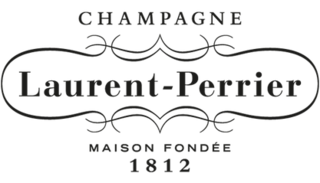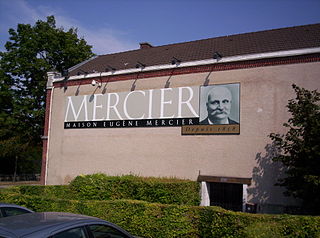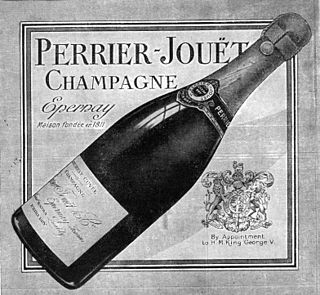Related Research Articles

Champagne is a sparkling wine originated and produced in the Champagne wine region of France under the rules of the appellation, which demand specific vineyard practices, sourcing of grapes exclusively from designated places within it, specific grape-pressing methods and secondary fermentation of the wine in the bottle to cause carbonation.
Krug Champagne is a Champagne house founded by Joseph Krug in 1843. It is based principally in Reims, the main city in France's Champagne region and is one of the famous Champagne houses that formed part of the Grandes marques. Today the house is majority owned by the multinational conglomerate LVMH Moët Hennessy – Louis Vuitton S.E. whose portfolio includes other well known wine brands such as Moët & Chandon, Veuve Clicquot, Château d'Yquem and Ruinart. Despite LVMH's majority ownership, the Krug family is still actively involved in all the key decisions of the house but does not manage the day-to-day operations.

Bollinger is a French Champagne house, a producer of luxury sparkling wines from the Champagne region. They produce several labels of Champagne under the Bollinger name, including the vintage Vieilles Vignes Françaises, Grande Année and R.D. as well as the non-vintage Special Cuvée. Founded in 1829 in Aÿ by Hennequin de Villermont, Paul Renaudin and Jacques Bollinger, the house continues to be run by members of the Bollinger family. In Britain, Bollinger Champagnes are affectionately known as "Bolly".

Champagne Lanson is a Champagne producer that is based in Reims in the Champagne region. Since 2006, it has been owned by the Lanson-BCC group that is headed by Bruno Paillard.

Ruinart is the oldest established Champagne house, exclusively producing champagne since 1729. Founded by Nicolas Ruinart in the Champagne region in the city of Reims, it is currently owned by LVMH Moët Hennessy Louis Vuitton SA.

The Loire Valley wine region includes the French wine regions situated along the river Loire from the Muscadet region near the city of Nantes on the Atlantic coast to the region of Sancerre and Pouilly-Fumé just southeast of the city of Orléans in north central France. In between are the regions of Anjou wine, Saumur, Bourgueil, Chinon, and Vouvray. The Loire Valley itself follows the river through the Loire department to the river's origins in the Cévennes but the majority of the wine production takes place in the regions noted above. The area includes 87 appellations under the Appellation d'origine contrôlée (AOC) and Indication Géographique Protégée (IGP) systems. While the majority of production is white wine from the Chenin blanc, Sauvignon blanc and Melon de Bourgogne grapes, there are red wines made from Cabernet franc. In addition to still wines, rosé, sparkling and dessert wines are also produced. With Crémant production throughout the Loire, it is the second largest sparkling wine producer in France after Champagne. Among these different wine styles, Loire wines tend to exhibit characteristic fruitiness with fresh, crisp flavors-especially in their youth. The Loire Valley has a long history of winemaking dating back to the 1st century. In the High Middle Ages, the wines of the Loire Valley were the most esteemed wines in England and France, even more prized than those from Bordeaux.

Champagne Salon is a small producer of Champagne made in the blanc de blancs style. Salon, along with Delamotte, is part of the Laurent-Perrier group since 1989.

Le Mesnil-sur-Oger is a commune in the Marne department in the Grand Est region in north-eastern France.

Laurent-Perrier is a Champagne house founded in 1812. It is the main company of the Laurent-Perrier Group, whose other flagship brands include the houses of Salon, De Castellane and Delamotte. Laurent-Perrier Group also acquired Chateau Malakoff as of 2004. With over 1,200 grape growers with supply contracts, Laurent-Perrier exports to more than 120 countries.
Arbane is a white French wine grape variety that has been historically grown in the Aube region of Champagne, but has now all but disappeared from the vineyards with less than 1 hectare left in France in 2006. Despite its rarity, it is still permitted grape variety to be blended with Chardonnay, Pinot noir and Pinot Meunier and other varieties in the Champagne cuvée.

Duval-Leroy is a Champagne producer based in Vertus, a village in the Côte des Blancs region of Champagne. The house, founded in 1859, produces both vintage and non-vintage cuvées as well as a line of organic wines. The house of Duval-Leroy is also known for its pioneering role in promoting a sustainable development model for its viticulture.
Henriot is a Champagne producer based in the Reims region of Champagne. The house, founded in Reims 1808, produces both vintage and non-vintage cuvée. Henriot has been under family ownership since 1994 when Joseph Henriot left Veuve Clicquot to manage the estate. Henriot's cellar master Laurent Fresnet, who was named "Sparkling Winemaker of the Year" by International Wine Challenge in 2015 and 2016, has said:
What makes our champagne so special is that it is sourced from beautiful terroirs, mostly Grand & Premier Cru vineyards. Thanks to our independent status, I can dedicate the time and care they require to craft the most luminous champagnes and perpetuate the unique style of the House.

Mercier is a Champagne producer based in the Épernay region of Champagne. The house, founded in 1858 by Eugène Mercier, produces both vintage and non-vintage cuvée, which is stored in 18 km (11 mi) long cellar tunnels located 30 m (98 ft) underground. Parts of the cellar are open to the public, where visitors can use rail carts to navigate the tunnels. Today, the house owns 576 ha of vineyards. Mercier owned the original rights to the name Dom Pérignon but gave the brand to Moët et Chandon in 1927. Today the house is under the umbrella of the LVMH group and is the number one selling brand of Champagne in the domestic French market.

Perrier-Jouët is a Champagne producer based in the Épernay region of Champagne. The house was founded in 1811 by Pierre-Nicolas Perrier and Rose Adélaide Jouët, and produces both vintage and non-vintage cuvee, approximately 3,000,000 bottles annually, with its prestige label named Belle Epoque.

The classification of Champagne vineyards developed in the mid-20th century as a means of setting the price of grapes grown through the villages of the Champagne wine region. Unlike the classification of Bordeaux wine estates or Burgundy Grand cru vineyards, the classification of Champagne is broken down based on what village the vineyards are located in. A percentile system known as the Échelle des Crus acts as a pro-rata system for determining grape prices. Vineyards located in villages with high rates will receive higher prices for their grapes than vineyards located in villages with a lower rating. While the Échelle des Crus system was originally conceived as a 1-100 point scale, in practice, the lowest rated villages are rated at 80%. Premier crus villages are rated between 90 and 99 percent while the highest rated villages, with 100% ratings are Grand crus.

A clos is a walled vineyard. Walled vineyards protected the grapes from theft and may improve the mesoclimate. They were often the vineyards of Cistercian monasteries. The word is often used in the name of famous wines even when the wall no longer exists.
Bernard de Nonancourt was a French businessman, member of the French Resistance and president of the Laurent-Perrier champagne house for more than fifty years. Under de Nonancourt' s leadership, Laurent-Perrier expanded to become the world's third largest seller of champagne by 2005. He was known as "Le Grand Bernard" within the industry.

The Côte des Blancs is an area of Champagne vineyards. Located in the department of Marne, it lies south of Epernay, stretches for about 20 km, and had a vineyard area of 3,313 hectares in 2006. The Côte des Blancs is a mostly eastern-facing slope that owes its name to the color of the grape that is planted: 95% Chardonnay. Champagnes in this area include the term "blanc de blancs".

Boll & Cie is a Champagne house based in Reims, a producer of sparkling wines from the Champagne region of France, founded in 1853. With the exception of the Brut Rose, all Champagnes from Boll & Cie are blanc de blancs. Boll & Cie specializes in Brut Champagne, including a Grand Cru from the village of Le Mesnil-sur-Oger.
Pierre Moncuit is a Champagne house founded in Mesnil-sur-Oger in 1889. The vineyards are Grand Cru status. Since 1977, Nicole and Yves Moncuit, sister and brother, have managed the estate. Pierre Moncuit wines are produced from a single vintage, and no reserve wines are blended into the non-vintage offerings.
References
- ↑ "History of Champagne Delamotte". vineyardbrands.com. Retrieved 2022-12-26.
- ↑ "Delamotte – Union des Maisons de Champagne". maisons-champagne.com. Retrieved 2022-12-27.
- ↑ Delamotte Brand Sheet
- ↑ "Interview With Didier Depond President of Salon and Delamotte". BESTCHAMPAGNE. 2022-06-26. Retrieved 2022-12-28.
- ↑ MacNeil, Karen (2001). The Wine Bible . New York: Workman Publishing. pp. 184. ISBN 1-56305-434-5.
"DELAMOTTE BRAND SHEET" (PDF). Regalwineco.com. Retrieved July 18, 2022.